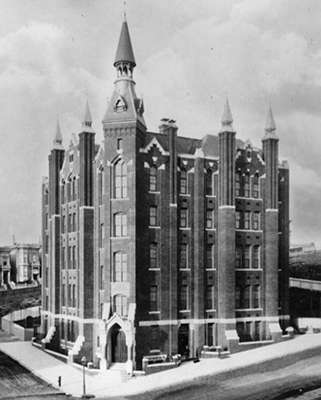Lane Medical Library
Lane Medical Library & Knowledge Management Center is the library of the Stanford University School of Medicine at Stanford University, near Palo Alto, California. Its mission is to "enable biomedical discovery by connecting people with knowledge".[1] It is located on campus adjacent to Stanford Hospital and Clinics. In addition to books, journals and documents for medical research and the teaching and practice of medicine, Lane Library houses a significant collection of material relating to the history of medicine.[2][3] The library also provides specialized search capabilities,[4] classes and tutorials, writing and grant support, and group and individual study spaces.
History

Levi Cooper Lane was a physician and surgeon in San Francisco in the 1800s. He served on the faculty of the Medical Department of the College of the Pacific, which was the first medical school on the Pacific Coast, founded in 1858 by Lane's uncle Elias Samuel Cooper. After Cooper's death in 1862 the medical school stopped operating. In 1870 Lane revived it, became president, and renamed it Medical College of the Pacific. In 1882 he changed the name to Cooper Medical College, named for his uncle, its founder. He built with his own funds a new brick medical school building at the corner of Sacramento and Webster streets, which served continuously as a medical school from 1882 until 1959.[5] He also built an adjacent hospital and nursing school, and made provision in his will for the construction of a library across the street from the college.[6]
Lane died on February 9, 1902, and his widow died in August 1902; in his widow's will, one third of Lane's estate was given to Cooper Medical College to establish a medical library.[7] In August 1906, the directors of Cooper Medical College passed a resolution establishing the Lane Medical Library.[7] In 1908, Stanford acquired Cooper Medical College as the nucleus for the Stanford Medical Department, now the Stanford University School of Medicine. In 1910 Stanford also acquired the assets of the Levi C. Lane Medical Library Trust, consisting of 30,000 volumes as well as a building site and funds for the building of a library.[8] Lane Library was dedicated November 3, 1912.[9] It was an integral part of the Stanford library system despite being located in San Francisco. It was the largest medical library west of Chicago.[2] The building still stands; it now houses the California Pacific Medical Center Health Sciences Library.[10][11] The medical school and Lane Library were moved to the main Stanford campus in 1959.[7]
References
- "Lane Medical Library". IRT (Information Resources and Technology). Stanford School of Medicine. Archived from the original on 21 September 2012. Retrieved 26 August 2012.
- Stam, David H. (2001). International Dictionary of Library Histories. 2. Chicago: Fitzroy Dearborn Publishers. pp. 707–708. ISBN 9781579582449.
- "Stanford Medical History Center". ArchivesWiki. American Historical Association. Retrieved 26 August 2012.
- Spector, Rosanne (November 22, 2010). "New search tools at Lane Library website for questions from both researchers, clinicians". Stanford School of Medicine. Archived from the original on 14 January 2011. Retrieved 26 August 2012.
- "The Advent of Cooper Medical College (1870-1912)". eLane. Lane Library. Archived from the original on 11 October 2012. Retrieved 25 August 2012.
- Wilbur, Ray Lyman; Carroll, Paul (1960). The Memoirs of Ray Lyman Wilbur, 1875-1949. pp. 79–80. ISBN 9780804700306.
- "Levi Cooper Lane, M.D. 1828-1902". Health Sciences Library. California Pacific Medical Center. Archived from the original on 2011-09-07. Retrieved 2012-08-26.
- Stanford University (1919). New Building of the Stanford University Library and a History of the Library 1891-1919. Stanford University.
stanford library.
- Library, Lane Medical (1912). "Dedication of the Lane Medical Library". Leland Stanford Jr. University. Retrieved 25 August 2012.
- California Pacific Medical Center Health Sciences Library
- Harris, Henry. California's Medical Story. San Francisco: Grabhorn Press, 1932. Page 239.